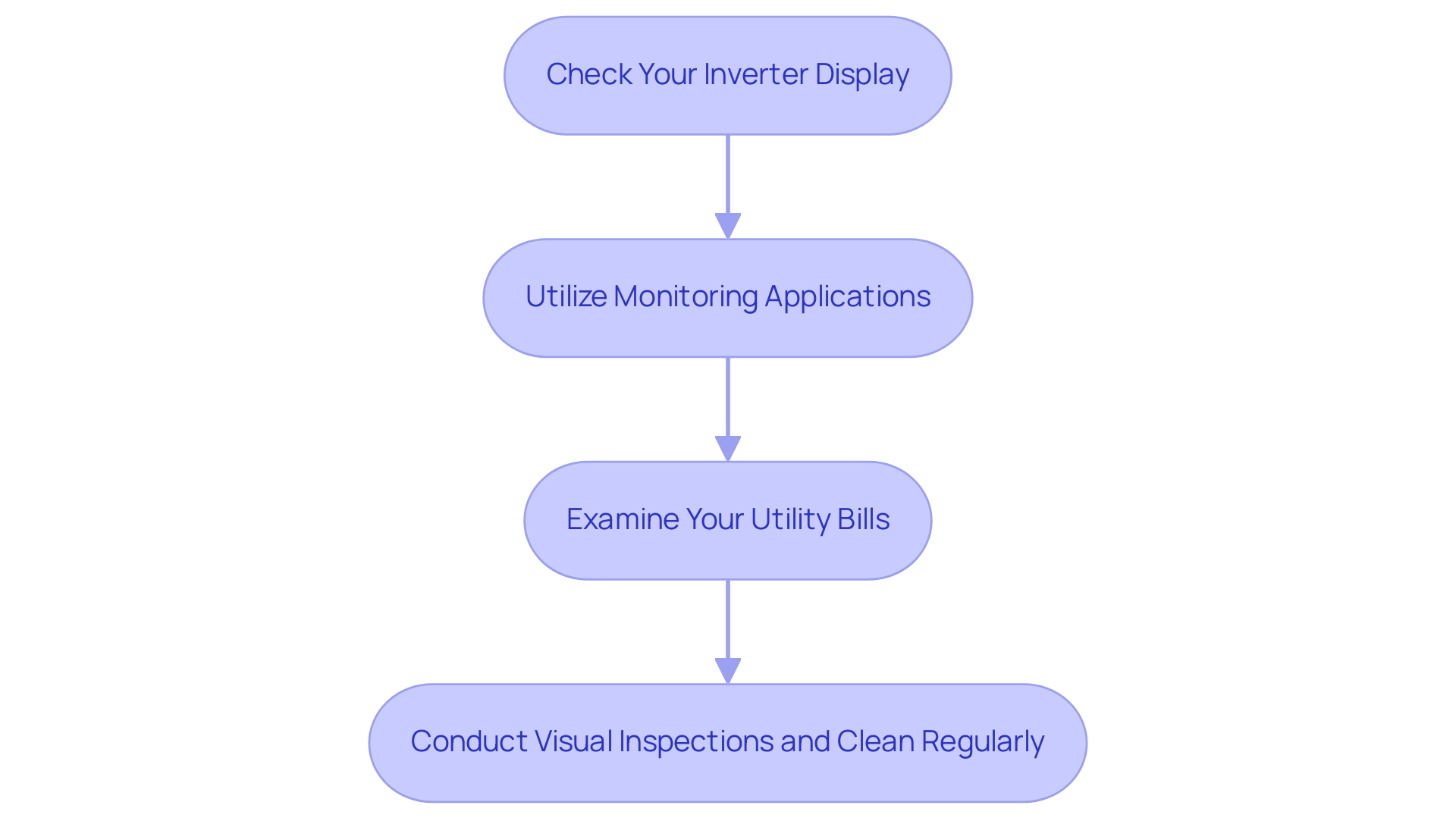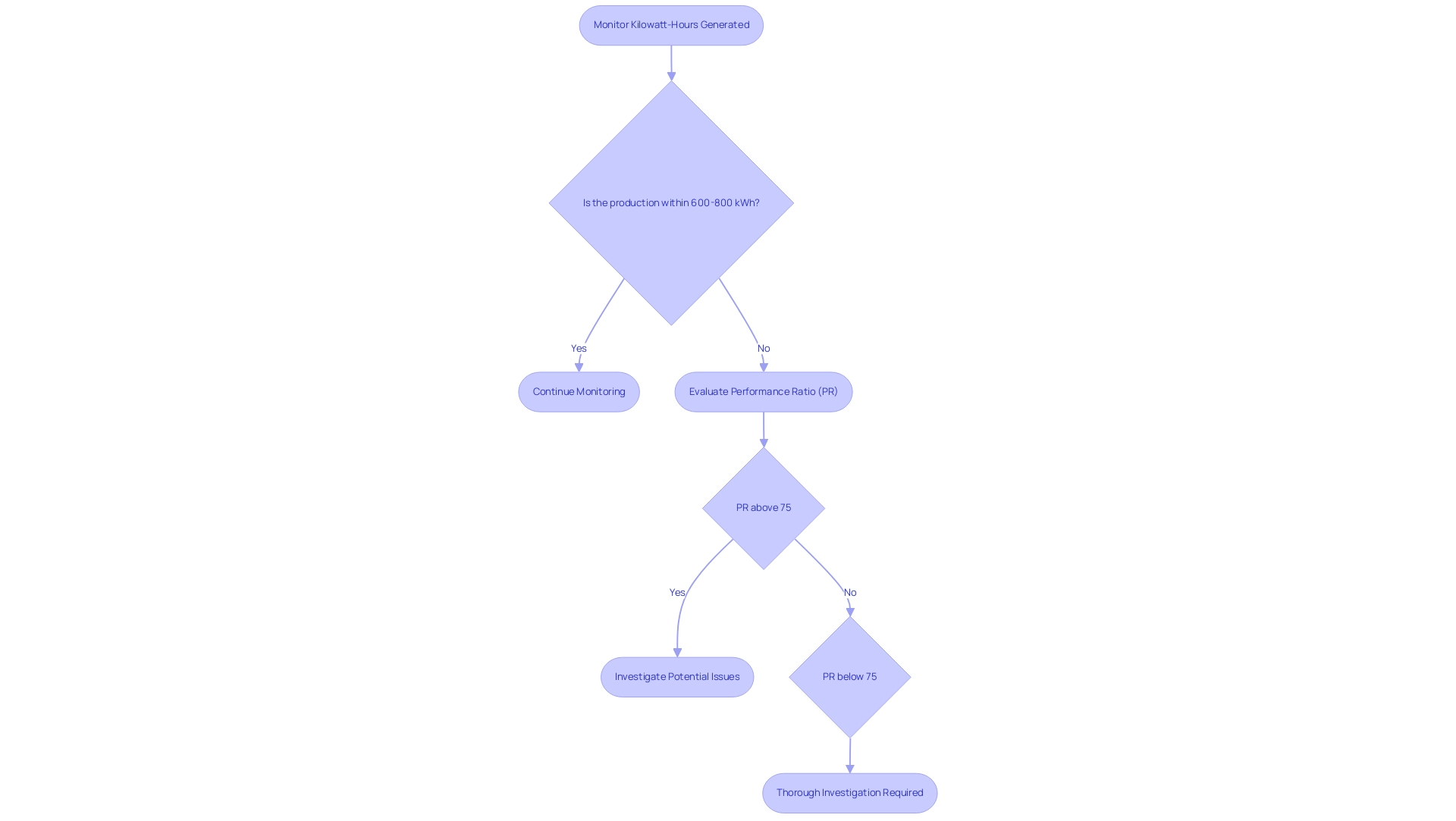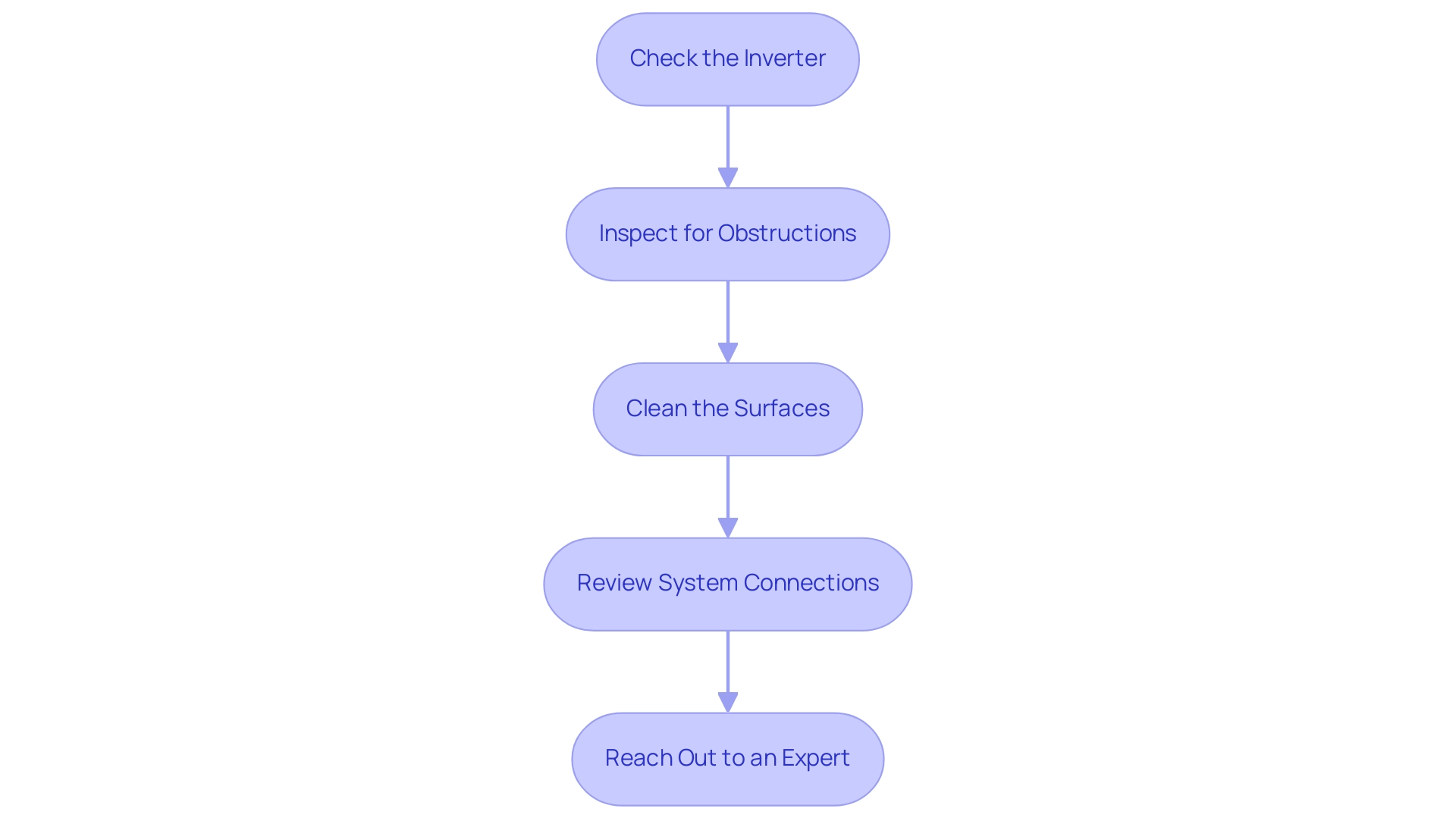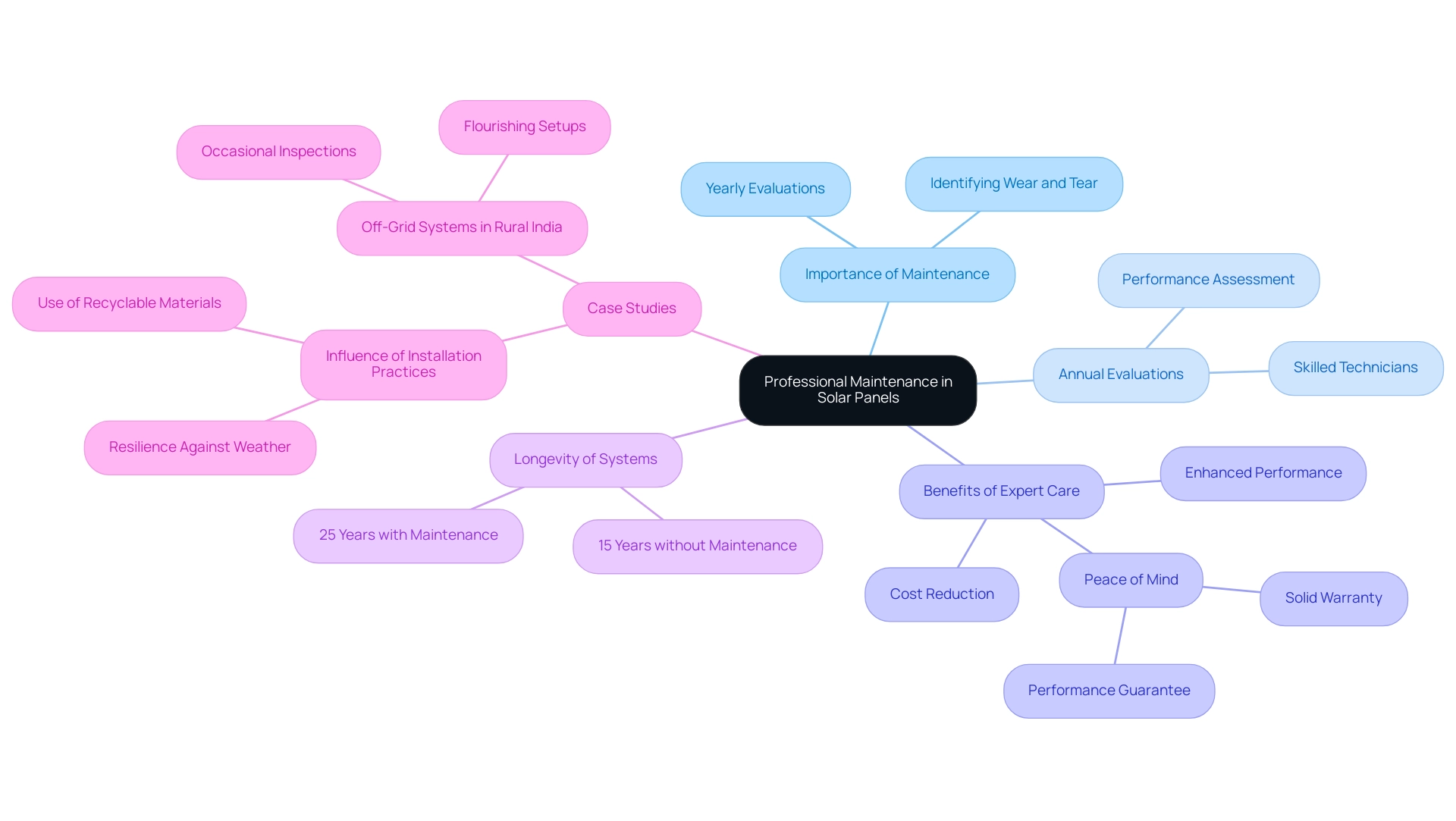Overview
To determine if solar panels are working effectively, homeowners should monitor the inverter display, utilize monitoring applications, analyze utility bills, and conduct regular visual inspections. The article emphasizes that these methods help identify performance issues, such as shading or dirt buildup, and ensure optimal energy production, reinforcing the importance of proactive maintenance and monitoring for maximizing the benefits of solar energy systems.
Introduction
As the world increasingly turns towards renewable energy sources, solar power stands out as a beacon of sustainability and efficiency. Understanding how solar panels work is essential for homeowners looking to harness the sun’s energy effectively. From the intricate process of converting sunlight into usable electricity to the importance of regular maintenance, the journey to optimizing solar energy systems is multifaceted.
This article delves into the mechanics of solar panel functionality, practical monitoring steps, and the impact of weather conditions on energy production, while also addressing troubleshooting methods for underperforming systems.
With advancements in technology and a growing demand for renewable energy, homeowners can take informed steps towards maximizing their solar investment and contributing to a greener future.
Understanding Solar Panel Functionality
Solar modules capture sunlight and transform it into electricity through a process involving photovoltaic (PV) cells. When sunlight strikes these cells, it generates direct current (DC) electricity, which is then transformed into alternating current (AC) electricity by an inverter, making it suitable for household use. Understanding how to know if solar panels are working is crucial for eco-conscious homeowners; being familiar with the core components—solar units, the inverter, and the monitoring system—empowers you to troubleshoot performance issues effectively.
If your energy collectors are underperforming, understanding how to know if solar panels are working can help identify possible causes, such as:
- Shading from nearby trees or structures
- Dirt buildup on the units
- Technical failures within the system
Furthermore, integrating battery backups from sunlight increases autonomy and guarantees dependable power during outages or severe weather. Recent advancements in photovoltaic technology as of 2024 reflect a significant focus on improving efficiency and reducing costs, solidifying this renewable resource’s role in modern power solutions.
In Q3 2024, 1.1 GW of residential photovoltaic systems were installed, marking a 4% decline quarter-over-quarter due to factors such as the depletion of California’s project queue and higher financing costs. However, demand remains high, driven by soaring electricity bills and power outages. Bloomberg New Energy Finance forecasts the renewable energy market to achieve an impressive capacity of 592 GW in 2024, underscoring the growing significance of this energy as a dependable power source.
Furthermore, 85% of installers using NREL’s SolarAPP+ permitting software report that it significantly eases the permitting process, highlighting the importance of streamlined installation procedures in the renewable energy sector. Regular maintenance of your energy panels ensures efficiency and longevity, and understanding how to know if solar panels are working can further enhance their performance with innovative cleaning solutions. To kickstart your journey towards sustainability, get your free personalized estimate today!
When choosing battery backups, consider options that provide the best efficiency and capacity customized to your power requirements.
Practical Steps to Monitor Your Solar Panels
- Check Your Inverter Display: The inverter display serves as an essential tool, providing real-time feedback on power production. Regularly verify how to know if solar panels are working by ensuring they are operational and displaying outputs that align with your expectations. A properly working inverter is crucial for enhancing the efficiency of your energy setup.
- Utilize Monitoring Applications: Many modern solar setups are equipped with advanced monitoring applications that provide extensive insights into power production and overall setup health. Download the appropriate app, log in to your account, and consistently review your system’s performance. These apps utilize AI technology, such as the Sense Monitor, which employs AI to generate profiles for identifying and monitoring the usage of individual appliances, including how to know if solar panels are working, enabling you to track performance efficiently.
- Examine Your Utility Bills: A practical method to evaluate your energy system’s effectiveness is to analyze your electricity bills before and after installation. A significant reduction in your power expenses is one way to know how to know if solar panels are working as expected, providing the advantages of renewable resources.
- Conduct Visual Inspections and Clean Regularly: Routine inspections of your solar installations are vital. To determine how to know if solar panels are working, look for dirt, debris, or any shading from nearby trees that could impede performance. Maintaining your surfaces is not merely a maintenance task; it can greatly enhance power generation and helps you understand how to know if solar panels are working, ensuring you maximize your investment. As one expert noted, “Did you notice a significant drop in power production? This issue can be due to a variety of factors that affect how to know if solar panels are working, with the most common being dust and debris buildup. However, understanding how to know if solar panels are working can help identify if the issue is caused by malfunctioning components. The most effective method to ascertain how to know if solar panels are working is via the process of elimination, beginning with cleaning the surface. Dust and debris can reduce efficiency by up to 0.75% annually, emphasizing the need for regular cleaning and maintenance. Additionally, researchers from the Indian Institute of Engineering Science and Technology have created a model to assess dust buildup on photovoltaic panels, which is essential for enhancing maintenance of the surfaces.
As the monitoring market for photovoltaic panels continues to grow, especially in areas like the Asia-Pacific—where supportive government policies and substantial investments in renewable sources are fueling development—remaining informed and proactive about your photovoltaic setup’s performance is more vital than ever. Based on a recent case study, the APAC region recorded the largest market share in the Panel Monitoring System market in 2022, highlighting the increasing significance of effective monitoring systems in optimizing renewable solutions. In addition to monitoring, exploring innovative cleaning services and battery storage options, such as those offered for Tesla home chargers, will further enhance your sustainable energy practices.
Monitoring Energy Production: Assessing Solar Panel Efficiency
To effectively assess how to know if solar panels are working, it is essential to monitor the kilowatt-hours (kWh) generated on a monthly basis. Comparing this data against expected production based on your setup size and local sunlight availability is crucial. For example, a well-optimized 5 kW energy array in California usually generates approximately 600-800 kWh each month.
Consistent production levels falling below this range may indicate how to know if solar panels are working, which requires attention. Additionally, understanding how to know if solar panels are working by evaluating the performance ratio (PR)—the actual output compared to the expected output—can provide further insights; a PR below 75% should prompt a thorough investigation into possible inefficiencies. Recent reports indicate that, as of 2024, performance benchmarks are becoming more stringent, which highlights how to know if solar panels are working for homeowners to stay vigilant.
For example, a recent case study titled ‘How Homeowners Benefited from Household Solar Systems Under the 200% Rule’ illustrated that a sewage tank pump failure went unnoticed until an unusual spike in electricity usage was detected, underscoring the importance of regular monitoring. Moreover, investing in high-efficiency heating solutions can result in substantial cost savings, with estimates indicating decreases in utility bills ranging from $400 to $600 each year. These systems are designed with thermal efficiency ratings that demonstrate their ability to convert sunlight into usable heat effectively.
The Solar Power Industries Association observes that the price of home photovoltaic systems has decreased by 40% in the past ten years, rendering these solutions more attainable and economically viable. By remaining proactive and knowledgeable about photovoltaic performance, including innovative cleaning technologies like automated cleaning robots and self-cleaning coatings, you can ensure optimal power production, enhance efficiency, and contribute to a healthier planet while also reducing greenhouse gas emissions.
How Weather Conditions Affect Solar Panel Performance
Weather conditions play a vital role in influencing the effectiveness of photovoltaic systems, with energy generation on overcast days still feasible but generally decreasing by 10-25%. This reduction is significant but not prohibitive, as photovoltaic systems can effectively harness diffuse sunlight. Interestingly, rainy weather can wash away dust and debris from surfaces, leading to improved efficiency once the rain subsides.
However, extreme temperatures present challenges; while photovoltaic panels are designed to endure high heat, the performance of inverters—essential elements that transform sunlight into usable electricity—can decrease under extreme conditions. Comprehending these nuances assists homeowners in understanding how to know if solar panels are working, especially in predicting fluctuations in power production due to varying weather patterns. Recent studies emphasize that even in less-than-ideal climates, photovoltaic systems can remain effective, with emissions in the first half of 2024 being nearly a third lower than in the same period in 2022, showcasing the significance of renewable power sources.
Furthermore, the case study titled ‘Impact of Solar Irradiance on Photovoltaic Performance’ demonstrates how solar irradiance influences power generation throughout the seasons; for instance, photovoltaic systems obtain more direct sunlight during summer, enhancing output, whereas winter generally leads to decreased production because of diminished irradiance. To assess the necessary power capacity for residences, homeowners should take into account factors such as consumption patterns, roof space, and local climate conditions. Additionally, when selecting panel inverters, it is essential to choose models that are compatible with the specific panel system and can operate efficiently under varying temperature conditions.
States such as New Mexico, Vermont, Virginia, and Wyoming are anticipated to produce over 90% of their electricity capacity from wind and sunlight by 2035, highlighting the crucial role of renewable resources in the contemporary power landscape. As remarked by Chris Rosslowe, Senior Energy & Climate Data Analyst at Ember: ‘We are witnessing a historic shift and it is happening rapidly.’ By managing expectations around these weather-related factors and following best practices for inverter selection, eco-conscious homeowners can understand how to know if solar panels are working, enabling them to make more informed decisions regarding their energy investments.
Troubleshooting Underperforming Solar Panels: What to Do Next
When you notice a drop in solar panel performance, there are several practical steps you can take to troubleshoot the issue effectively:
- Check the Inverter: Begin by verifying that the inverter is operational. If it displays an error code, refer to the manufacturer’s manual for specific troubleshooting instructions.
- Inspect for Obstructions: Examine the surfaces for any shading or debris that might obstruct sunlight. Even minor obstructions can significantly affect power production, as accumulated dust and dirt can hinder efficiency over time.
- Clean the Surfaces: If you notice dirt or grime buildup, gently clean the surfaces using a soft brush or hose. Regular cleaning is crucial for maintaining optimal energy production, especially since routine maintenance can reduce performance losses that average 0.75% per year. Avoid harsh chemicals, as they can damage the panels.
- Review System Connections: Ensure that all wiring and connections are secure. Loose connections can lead to inefficiencies, diminishing overall performance.
- Reach Out to an Expert: If the issues continue after these inspections, it’s recommended to seek a technician who can conduct a thorough assessment of your setup. As George Kelly noted, “the expertise of seasoned professionals can often identify issues that may not be immediately apparent to homeowners.”
It’s important to remember how to know if solar panels are working, since while minor repairs and maintenance can be handled independently, more complex issues, such as faulty wiring or inverter failures, require professional intervention to ensure safety and optimal functionality. Additionally, keep in mind that solar energy production can significantly decrease during winter months, particularly in northern states, due to low sun angles and atmospheric conditions. This seasonal impact can influence your setup’s performance, making it essential to monitor how to know if solar panels are working and troubleshoot accordingly.
For practical assessment, consider that a test load typically runs between 100W to 150W, providing a benchmark for evaluating your setup’s output.
Research from the Indian Institute of Engineering Science and Technology has developed a model to estimate dust accumulation on photovoltaic panels, which is crucial for both rooftop and commercial plants. This model considers factors such as particulate matter concentration, tilt angle, and weather parameters, providing a comprehensive tool for optimizing maintenance. Furthermore, recognizing that environmental factors can greatly affect photovoltaic systems is essential; for example, warmer climates may necessitate additional units to generate the same power output.
Exploring innovative cleaning solutions and understanding the broader context of renewable energy solutions, including Tesla home chargers and government programs, can further enhance your experience as an eco-conscious homeowner.
The Role of Professional Maintenance in Solar Panel Performance
Ensuring the longevity and efficiency of your panels hinges on the importance of professional maintenance, which is where a dedicated service company like Powercore Electric comes into play. In 2024, it is advisable to arrange yearly evaluations with skilled technicians who understand the unique electrical requirements of California communities. They can effectively evaluate performance, identify wear and tear, and tackle any emerging issues before they escalate.
Powercore’s commitment to unmatched quality craftsmanship ensures that these professionals conduct thorough cleaning and maintenance, going beyond what homeowners may manage on their own. Consistent expert assistance not only optimizes your energy investment but also improves overall performance. As noted by SolarAI,
- ‘A solid warranty covers losses and defects, while a performance guarantee gives you a baseline of how your systems should operate over time – assuring you some peace of mind.’
This level of assurance is invaluable when considering the significant financial investment that these systems represent. Additionally, Powercore Electric provides customizable maintenance plans and flexible scheduling choices, making it easier for homeowners to care for their systems. The advantages of photovoltaic roofing include reduced energy costs and enhanced property value, which are essential factors for eco-conscious homeowners.
For example, research shows that photovoltaic systems with routine expert upkeep can last 25 years or longer, in contrast to only 15 years without it. Moreover, case studies indicate that proper installation and ongoing professional maintenance can significantly enhance the resilience of photovoltaic systems against extreme weather and improve sustainability through the use of recyclable materials. Specifically, the case study on the influence of installation practices demonstrates that well-secured structures and the use of recyclable materials not only enhance durability but also contribute to long-term performance, reinforcing the need for professional care.
Off-grid energy panel installations in rural India demonstrate that with occasional inspections and cleaning, these setups can flourish, emphasizing the advantages of continuous professional upkeep. Expect your solar technician from Powercore to provide comprehensive insights during inspections on how to know if solar panels are working, ensuring your system operates at peak efficiency for years to come, transforming solar radiation into electricity for your home.
Conclusion
Harnessing solar energy requires a solid understanding of solar panel mechanics, effective monitoring, and proactive maintenance. Knowledge of how photovoltaic cells convert sunlight into electricity and the critical role of inverters is essential for homeowners aiming to maximize their solar investment. Regular maintenance and cleaning are vital for optimal performance, while ongoing technological advancements enhance efficiency.
Monitoring energy production is crucial for assessing solar system efficiency. Homeowners can utilize:
- inverter displays
- monitoring apps
- utility bill analysis
to gain insights into energy generation. Weather conditions may affect production, but solar panels can still perform effectively in various climates.
Troubleshooting underperforming panels involves:
- checking the inverter
- inspecting for obstructions
- ensuring secure connections
Professional maintenance through regular inspections ensures the longevity and efficiency of solar installations, enhancing resilience against environmental factors.
In summary, transitioning to solar energy is a commitment to sustainability and a strategic investment for future savings. By understanding solar technology, being vigilant about maintenance, and leveraging advancements in the field, homeowners can significantly contribute to a greener future while enjoying the financial benefits of solar power. The journey toward optimizing solar energy systems is ongoing, but informed decisions can yield substantial rewards for both homeowners and the planet.








